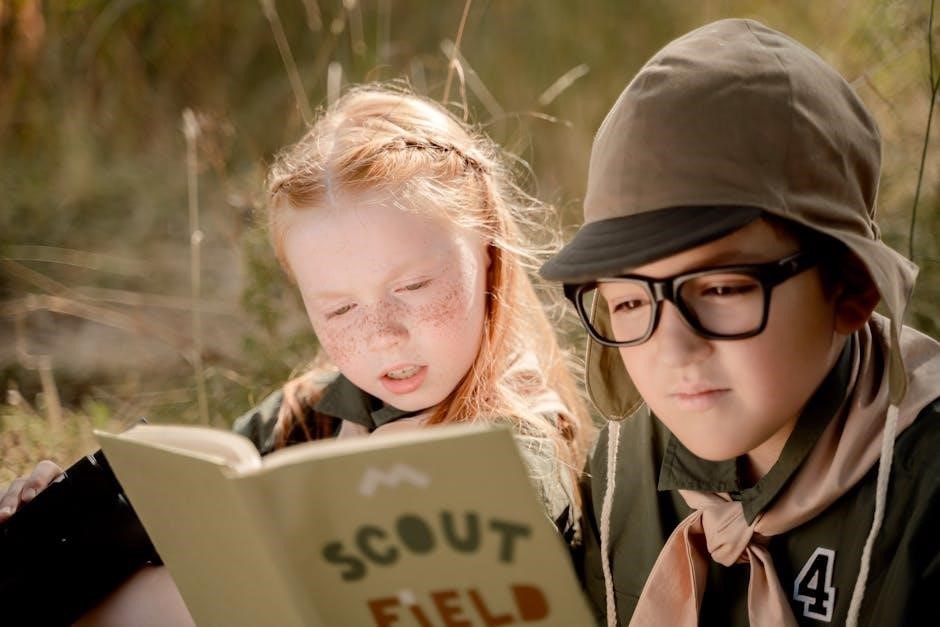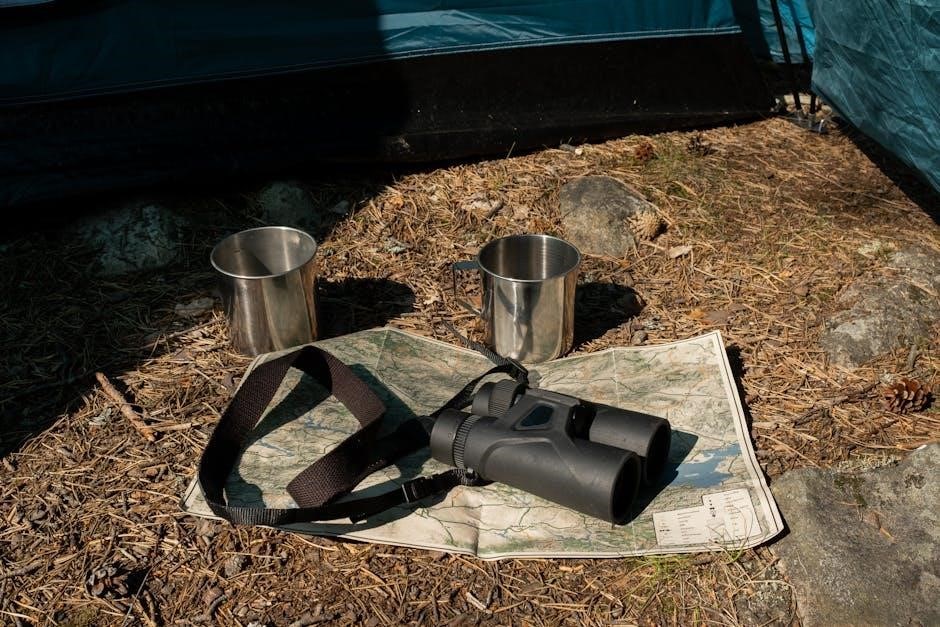The Guide to Safe Scouting is a vital resource for conducting Scouting activities safely and responsibly, established through decades of experience and updated regularly to reflect current policies and best practices.
1.1 Purpose of the Guide
The Guide to Safe Scouting serves as a comprehensive resource to prepare adult leaders and members of Scouting America to conduct activities safely and responsibly. Its primary purpose is to protect participants from known hazards identified over decades of Scouting experience. By outlining policies, procedures, and best practices, the guide ensures that all activities are conducted with prudence and care. It emphasizes qualified supervision, risk management, and adherence to safety guidelines to create a secure environment for youth, volunteers, and staff. The guide is essential for fostering a culture of safety and accountability within Scouting programs.
1.2 Importance of Safety in Scouting
Safety is a cornerstone of Scouting America, ensuring that all activities are conducted in a secure and responsible manner. The Guide to Safe Scouting underscores the importance of protecting youth, volunteers, and staff from potential risks. By adhering to established protocols and guidelines, leaders can minimize hazards and create an environment where participants feel safe and supported; Safety is not just a policy but a shared responsibility among all members, fostering trust and confidence in Scouting programs. It ensures that every experience is both educational and enjoyable, aligning with the organization’s commitment to youth development and well-being.
Evolution of the Guide to Safe Scouting
The Guide to Safe Scouting has evolved over decades, adapting to new risks and technologies while maintaining its core mission of safeguarding Scouting activities through updated policies and best practices.
2.1 Historical Background
The Guide to Safe Scouting was first introduced to address safety concerns in Scouting activities, drawing from decades of experience. Initially, it focused on basic safety practices but evolved to include detailed policies for various activities. Over the years, updates have reflected changing risks, such as advancements in technology and new activity guidelines. The guide has also incorporated lessons learned from past incidents, ensuring it remains relevant and effective. Its historical development underscores the organization’s commitment to protecting participants and leaders, adapting to modern challenges while maintaining its foundational principles of safety and responsibility.
2.2 Updates and Revisions
The Guide to Safe Scouting undergoes regular updates to reflect new safety standards and emerging risks. Revisions include incorporating feedback from leaders, incidents, and legal requirements. Recent changes address inclusivity, such as Scouting America’s rebranding, and emphasize youth protection policies; The guide now aligns with modern activities like climbing and water sports, ensuring comprehensive safety measures. These updates ensure the guide remains a trusted resource for leaders, enabling them to deliver programs safely and effectively, while addressing contemporary challenges and fostering a culture of continuous improvement in safety practices across all Scouting activities.

Key Principles of Safe Scouting
The foundation of safe scouting includes qualified supervision, risk management, and the SAFE methodology, ensuring all activities are conducted with prudence and attention to participant well-being.
3.1 Supervision and Leadership
Effective supervision and leadership are critical to ensuring a safe and positive Scouting experience. Leaders must be qualified, trustworthy, and trained to manage risks and make informed decisions. The “sandwich principle” emphasizes that adults should position themselves to observe and guide without directly participating in youth-led activities. Proper supervision ensures compliance with safety guidelines and fosters an environment where youth can thrive. Leaders are responsible for setting a safety-conscious example, promoting discipline, and maintaining open communication. This approach helps prevent accidents and ensures all activities align with Scouting values and safety standards.
3.2 Risk Management
Risk management is a cornerstone of the Guide to Safe Scouting, focusing on identifying, assessing, and mitigating potential hazards. Leaders are trained to evaluate risks associated with activities and implement controls to minimize harm. This process involves understanding the environment, equipment, and participant capabilities. By applying the SAFE methodology—Supervision, Accountability, Fitness, and Education—leaders ensure a proactive approach to safety. Regular training and updates help leaders stay informed about best practices, enabling them to address risks effectively and provide a secure environment for all Scouting activities. Effective risk management is essential for a successful and injury-free program.
3.3 The SAFE Methodology
The SAFE methodology is a foundational framework in the Guide to Safe Scouting, designed to ensure activities are conducted with utmost safety. It emphasizes four key principles: Supervision, Accountability, Fitness, and Education. Supervision ensures qualified leaders monitor activities, while Accountability requires leaders to take responsibility for safety measures. Fitness involves ensuring participants are physically and mentally prepared. Education focuses on training leaders and informing participants about risks. By applying these principles, the SAFE methodology helps create a secure environment for all Scouting activities, promoting a culture of safety and preparedness.

Leadership and Responsibility
Leadership and responsibility are critical in Scouting, ensuring activities are conducted safely. Leaders must adhere to guidelines, supervise effectively, and make informed decisions to protect participants.
4.1 Qualified Supervision
Qualified supervision is crucial for ensuring safety in Scouting activities. Leaders must be trained, experienced, and capable of managing risks effectively. The Sandwich Principle emphasizes that activities should be supervised by at least two qualified adults to maintain safety and accountability. Proper supervision ensures that participants follow guidelines and that leaders can respond appropriately to emergencies. Leaders are expected to set a positive example, enforce safety protocols, and provide guidance to youth members. Effective supervision fosters a safe and respectful environment, allowing Scouts to thrive and learn responsibly. Leaders must always prioritize safety and adhere to established policies and procedures.
4.2 The Sandwich Principle
The Sandwich Principle is a key component of safe supervision in Scouting, requiring two qualified adults to oversee activities. This ensures a layered approach to safety, where one adult focuses on program delivery while the other monitors overall safety. The principle helps prevent accidents by maintaining proper oversight and adherence to safety guidelines. It also promotes accountability, as both leaders are responsible for ensuring a safe environment. By following this principle, Scouting activities become more structured, reducing risks and fostering a secure setting for youth to participate and learn effectively.

Health and Safety Guidelines
The Health and Safety Guidelines in the Guide to Safe Scouting outline essential practices for maintaining physical well-being and emergency readiness in all Scouting activities.
5.1 Physical Health Requirements
The Guide to Safe Scouting emphasizes the importance of physical health requirements to ensure all participants can safely engage in Scouting activities. Medical evaluations are necessary to identify potential health risks, while leaders must accommodate dietary needs and physical limitations. Understanding these requirements helps prevent health-related incidents and ensures a safe environment for everyone. By adhering to these guidelines, Scouting America promotes inclusivity and safety, allowing all members to participate fully in activities.
5.2 First Aid and Emergency Preparedness
First aid and emergency preparedness are critical components of safe Scouting practices. Leaders must complete first aid training to handle injuries effectively. A well-stocked first aid kit should always be available, and emergency contact information must be accessible. The Guide to Safe Scouting emphasizes creating emergency action plans tailored to specific activities. Prompt reporting of incidents ensures proper care and documentation. Regular drills and training help leaders and participants respond confidently in crisis situations, minimizing risks and ensuring a swift, organized response to emergencies.

Youth Protection Policies
Scouting America prioritizes youth protection through comprehensive policies, including mandatory training, background checks, and the two-deep leadership rule, ensuring a safe and trustworthy environment for all participants.
6.1 Prevention of Abuse
The prevention of abuse is a cornerstone of Scouting America’s youth protection policies. Mandatory training for leaders and volunteers ensures they recognize and report suspicious behavior. Background checks are conducted on all adult members, and the two-deep leadership rule requires at least two registered adults to be present during activities. This multi-layered approach minimizes risks and fosters a culture of safety and accountability, protecting young participants from harm and ensuring their well-being is always the top priority.
6.2 Reporting Incidents
Reporting incidents promptly and accurately is essential to ensure accountability and maintain a safe environment. Leaders must immediately notify local authorities and Scouting America if any abuse or misconduct occurs. Detailed documentation of incidents, including dates, times, and witness statements, is required. All reports are confidential to protect privacy and prevent retaliation. Timely reporting allows for swift action, ensuring the well-being of participants and upholding the organization’s commitment to safety. Proper communication channels and procedures are outlined in the Guide to Safe Scouting to facilitate transparent and efficient reporting processes.
Activity-Specific Safety Measures
Activity-specific safety measures ensure participants engage in camping, climbing, rappelling, and water activities safely. Guidelines emphasize qualified supervision and adherence to established protocols to minimize risks.
7.1 Camping Safety
Camping safety requires thorough preparation and adherence to established guidelines. Leaders must ensure proper site selection, equipment inspection, and weather monitoring. Participants should be trained in fire safety, food handling, and emergency procedures. The Guide to Safe Scouting emphasizes the importance of qualified adult supervision and the use of the SAFE Methodology to mitigate risks. Additionally, all campers must follow health and safety protocols, including proper hygiene and first aid preparedness. These measures ensure a secure and enjoyable outdoor experience for all participants.
7.2 Climbing and Rappelling Safety
Climbing and rappelling activities require strict adherence to safety protocols to minimize risks. The Guide to Safe Scouting mandates that all participants be properly trained and equipped with approved gear, including helmets and ropes. Leaders must ensure that climbers are physically prepared and mentally capable for the activity. Weather conditions, equipment integrity, and terrain assessment are critical factors. Supervisors should enforce safety guidelines, such as proper belaying techniques and emergency response plans. The SAFE Methodology is essential for evaluating and mitigating hazards, ensuring a secure environment for all climbers and rappellers.
7.3 Water Activities Safety
Water activities require careful planning and supervision to ensure participant safety. The Guide to Safe Scouting emphasizes the importance of trained adult leadership and adherence to BSA Aquatics Supervision policies. All participants must pass a swim test or use properly fitting life jackets. A buddy system should always be in place, and activities must be tailored to the skill level of the group. Environmental hazards, such as strong currents or cold water, must be assessed and mitigated. A clear emergency response plan is essential to handle incidents effectively, ensuring a safe and enjoyable experience for all participants.

Firearms and Shooting Sports Safety
The Guide to Safe Scouting outlines essential safety protocols for firearms and shooting sports, ensuring proper training, adult supervision, and adherence to established guidelines to prevent accidents.
8.1 Handling Firearms
Handling firearms in Scouting activities requires strict adherence to safety guidelines. Leaders must ensure participants are properly trained and certified. All firearms must be stored securely, following local laws and BSA policies. Supervision by qualified adults is mandatory. Eye and ear protection should always be worn. Firearms must never be pointed at individuals or used in horseplay. Only authorized personnel may handle firearms, emphasizing safety and discipline. These precautions ensure a secure environment for all participants, aligning with Scouting America’s commitment to responsible firearm practices.
8.2 Shooting Sports Guidelines
Shooting sports in Scouting must follow specific guidelines to ensure safety and compliance. Activities must be supervised by certified instructors, adhering to BSA standards and local regulations. Participants must complete safety training before engaging in any shooting sport. Equipment inspection is mandatory, and proper safety gear must be worn at all times. Range operations should emphasize discipline and responsibility, prohibiting horseplay or unauthorized use of firearms. These guidelines ensure a safe and educational experience, fostering respect for firearms and promoting skill development among Scouts. Safety remains the top priority in all shooting sports activities conducted under Scouting America’s oversight.

Legal and Regulatory Compliance
Scouting activities must adhere to state and local regulations, ensuring compliance with legal standards. Liability protection and insurance coverage are critical to safeguarding participants and leaders during events.
9.1 State and Local Regulations
Unit leaders must be aware of and comply with state and local regulations that may supersede Boy Scouts of America policies. These regulations ensure activities are conducted legally and safely. Knowledge of specific laws governing camping, firearms, and water activities is essential. Leaders should verify local requirements before planning events. Compliance with these regulations is critical to maintaining a safe environment for all participants. Awareness of legal standards helps prevent violations and ensures adherence to both Scouting and governmental guidelines. This proactive approach fosters a culture of safety and responsibility within Scouting America programs.
9.2 Liability and Insurance
Likewise, liability and insurance are critical components of Scouting safety. The Boy Scouts of America provides insurance coverage for registered members, including participants and leaders, during official Scouting activities. Understanding the scope of this coverage is essential for leaders to ensure adequate protection. While insurance mitigates risks, it does not replace proactive safety measures. Leaders must remain vigilant in adhering to safety guidelines to minimize potential incidents. Insurance coverage complements the organization’s commitment to providing a secure environment for all participants, fostering trust and accountability at every level of Scouting operations.

Communication and Transparency
Open communication and transparency are essential in maintaining trust and accountability within Scouting activities. Leaders must ensure clear, timely information sharing with participants, parents, and stakeholders to foster a culture of safety and responsibility.
10.1 Incident Reporting
Incident reporting is a critical component of maintaining safety and accountability in Scouting activities. All incidents, including injuries, near misses, or safety concerns, must be reported promptly and accurately. Leaders should ensure that incidents are documented using appropriate forms and submitted to the relevant authorities, such as local councils or Scouting America’s national office. Timely reporting allows for proper investigation, implementation of corrective actions, and prevention of future incidents. Open communication and transparency in reporting foster a culture of safety, ensuring that all participants and stakeholders are informed and protected.
10.2 Parent and Participant Communication
Effective communication between leaders, parents, and participants is essential for ensuring safety and trust in Scouting activities. Leaders should maintain open and transparent dialogue, providing clear information about activity plans, safety measures, and any potential risks. Parents and participants should be encouraged to ask questions and share concerns. Regular updates and feedback loops help build confidence and ensure that everyone is informed and aligned. Clear communication also fosters a collaborative environment where safety is a shared responsibility, enhancing the overall Scouting experience for all involved.

Training and Education
Training and education are critical for preparing leaders with updated safety policies, risk management strategies, and the SAFE methodology, fostering a culture of safety in Scouting activities.
11.1 Health and Safety Course Syllabus
The health and safety course syllabus provides comprehensive training for leaders, focusing on risk assessment, emergency preparedness, and first aid. Modules include the SAFE methodology, youth protection, and incident reporting. Leaders learn to identify hazards, implement safety protocols, and respond effectively in crises. The syllabus emphasizes the importance of qualified supervision and the Sandwich Principle to ensure a safe environment for all participants. Regular updates reflect the latest policies and best practices, equipping leaders with the knowledge and skills to conduct Scouting activities responsibly and safely.
11.2 The Role of Training in Safety
Training is a cornerstone of maintaining safety in Scouting, ensuring leaders are equipped with the knowledge and skills to prevent accidents and manage risks effectively. The Guide to Safe Scouting emphasizes that comprehensive training programs, including health and safety courses, empower leaders to create a secure environment for youth. By fostering a culture of preparedness and accountability, training helps leaders anticipate potential hazards, respond to emergencies, and uphold the highest safety standards. Regular training updates ensure that leaders stay informed about evolving policies and best practices, reinforcing their commitment to participant well-being and safety in all Scouting activities.

Scouting America’s Commitment to Safety
Scouting America prioritizes safety, ensuring all activities are conducted with the highest standards of protection and accountability, reflecting its unwavering dedication to the well-being of all participants.
12.1 No Compromise on Safety
Scouting America maintains a steadfast commitment to safety, refusing to compromise on protocols that protect youth, volunteers, and staff. This principle ensures all activities are conducted with rigorous adherence to established guidelines, fostering trust and confidence among participants and families. By prioritizing safety above all else, Scouting America upholds its mission to provide a secure environment for character development and adventure.
12.2 Accountability at All Levels
Accountability is a cornerstone of Scouting America’s safety framework, ensuring every leader, volunteer, and participant adheres to safety protocols. Leaders are responsible for enforcing guidelines, while members are expected to follow them diligently. This collective accountability fosters a culture of safety, where everyone plays a role in preventing accidents and addressing incidents promptly. By holding all levels accountable, Scouting America maintains a secure and reliable environment for its programs.
The Role of the Guide in Modern Scouting
The Guide to Safe Scouting remains a vital resource, offering practical tools and updated policies to ensure safety in diverse Scouting activities, reflecting modern challenges and advancements.
13.1 Relevance in Today’s Scouting
The Guide to Safe Scouting remains highly relevant, providing updated policies and best practices for modern Scouting activities. It addresses diverse programs, including camping, climbing, and water activities, ensuring safety protocols align with current risks. The guide emphasizes leadership training, youth protection, and compliance with state and local regulations. Its focus on the SAFE methodology and the Sandwich Principle underscores the importance of supervision and risk management. As Scouting evolves, the guide adapts, reflecting the organization’s commitment to safety and inclusivity, such as the transition to Scouting America.
13.2 Application in Diverse Scouting Activities
The Guide to Safe Scouting is integral across various Scouting activities, ensuring safety in camping, climbing, and water sports. It provides specific guidelines for each, like proper supervision and equipment checks. The guide also covers firearms safety and first aid preparedness. Its principles, such as the SAFE methodology, are applied universally, fostering a culture of risk management and accountability. By tailoring safety practices to each activity, the guide ensures that all participants can engage confidently, knowing their well-being is prioritized in every Scouting experience.
The Guide to Safe Scouting underscores the importance of safety, preparedness, and continuous improvement in Scouting. It balances fun with responsibility, ensuring all activities are conducted prudently and safely.
14.1 Summary of Key Points
The Guide to Safe Scouting emphasizes qualified supervision, risk management, and the SAFE methodology to ensure all activities are conducted safely. It outlines health guidelines, youth protection policies, and specific safety measures for activities like camping and water sports. Compliance with local regulations and maintaining open communication with parents are stressed. The guide is a comprehensive resource for leaders, promoting a culture of safety and accountability within Scouting America, ensuring a secure environment for all participants.
14.2 Future of Safe Scouting Practices
The future of safe Scouting practices lies in continuous improvement and adaptability. By leveraging technology, such as safety apps and real-time incident reporting tools, Scouting America aims to enhance safety protocols. Emphasizing inclusivity and diversity, the organization will ensure all members feel safe and valued. Ongoing training and education for leaders will remain a priority, fostering a culture of accountability and preparedness. As new challenges emerge, the Guide to Safe Scouting will evolve to address them, ensuring Scouting remains a secure and enriching experience for generations to come.
